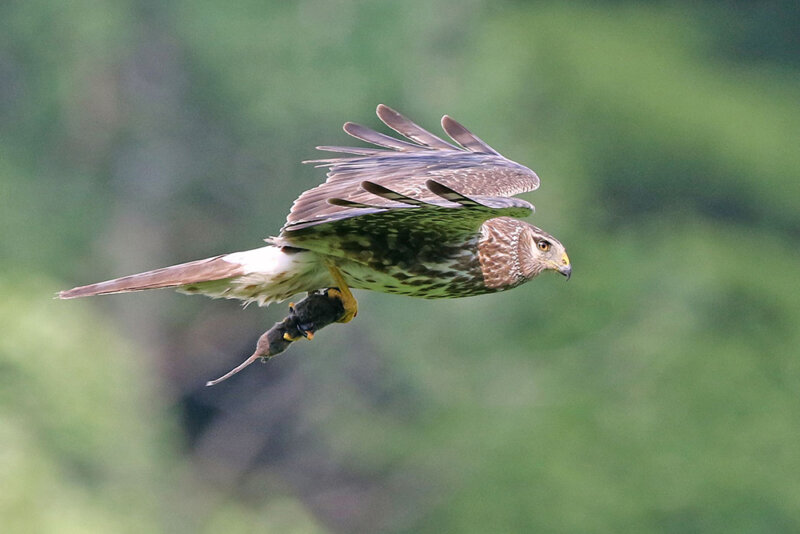We should just let forest symbiosis be without judging
Forests are natural communities, thousands of species engaged in the vital, and often brutal, practice of life. Forests are defined not just by the organisms that inhabit them but also by the relationships between these organisms, the many forms of symbiosis.
Symbiosis is a commonly used and commonly misunderstood term. While most people confuse symbiosis with mutualism — a mutually beneficial relationship between organisms — symbiosis is actually any close relationship between organisms. The forms of symbiosis include mutualism, commensalism (a relationship where one organism benefits and the other is unaffected), parasitism (one benefits and the other is harmed), competition and predation. While some forms of symbiosis are more charismatic than others, each is foundational to the function of our forests.

This Northern harrier is an example of predatory symbiosis which is just as valid and necessary as other types of symbiosis.
As much as we would love to believe that all the relationships in forests are mutualistic, they aren’t. While mutualisms exist and are undoubtedly important, our bias towards them can lead to misunderstandings about how forests work and what it means to care for them. Nowhere is this more apparent than in the public fascination with the relationship between trees and mycorrhizal fungi (the “Wood Wide Web”).
While we know that trees and mycorrhizal fungi can, and often do, have mutualistic relationships, the public excitement surrounding these relationships has outpaced the research, largely fueled by the book “The Hidden Life of Trees” by Peter Wohlleben. While we know that trees benefit from relationships with some types of mycorrhizae, and that mycorrhizal networks can facilitate the movement of resources from one tree to another, a vision of forests as entirely connected, entirely altruistic, entirely cooperative communities is not supported by science.
When we look closely at the mutualisms in our forests, we often find that one species or another is getting the better part of the deal. Myrmecochory (the dispersal of plant seeds by ants, as we see with many of our spring ephemeral wildflowers) has long been considered a mutualism, but some ecologists have suggested that it is actually a subtle parasitism, that some plants are exploiting ants, distracting them from more valuable foraging elsewhere.
There are also conditional mutualisms: relationships which are mutualistic sometimes, depending on conditions. For instance, a mutualism between trees and some types of mycorrhizal fungi may become pathogenic or parasitic in certain circumstances.
Another example of this is synzoochory: the dispersal of tree seeds (like acorns) by seed-caching animals (like squirrels). While squirrels and oaks both benefit from this relationship when acorns are abundant — squirrels receive the nourishment of acorns and oaks receive the benefits of acorn dispersal — when acorns are scarce squirrels simply eat them all.
While parasitism and predation might be less easy to appreciate than mutualism, they are equally essential to forest ecology. Insects, which are the foundation of the forest’s food web, are often parasites, feeding on trees and plants. Predation of insects by creatures like songbirds and bats is vital to suppressing insect populations, keeping them from causing undue harm to trees and plants. When predation is removed or suppressed insect populations explode, and these relatively innocuous parasitic relationships can become harmful.
While we are quick to label a symbiosis between two species as one type or another, these relationships are fluid, dynamic and complex. An insect which is the pollinator of a tree (mutualistic) may also be a defoliator of the same tree (parasitic). Many of the species of invertebrates, bacteria and fungi which are pathogenic to trees (parasitic) also help break down organic material, which enriches soils and ultimately benefits trees (mutualistic). The closer we look at these symbioses, the more difficult they are to define and to categorize, and the less important naming them becomes.
As much as we would love to believe that forests are built on mutualism, the truth is that they are built on symbiosis: relationships which take many different forms.
If we can leave our judgements at the door, we can see that forests are as parasitic as they are mutualistic, that competition is as important as cooperation, that the death of a tree can be as beautiful as the birth of an animal. Our job as forest stewards is to care for forests as they are, not to place any form of symbiosis above the others.
(Ethan Tapper is the Chittenden County Forester for the Vermont Department of Forests, Parks and Recreation. See what he’s been up to, check out his YouTube channel, sign up for his eNews and read articles he’s written.)

